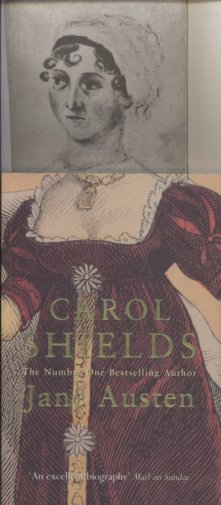Shields Carol
Jane Austen

I hope it is obvious, that only the lower part of the picture to the left shows the front of Shieldsī biography. The upper part was taken from a penguin edition of “Persuasion” from 1966. But I thought the reader should be granted a full view of Jane Austen. And these two different drawings of her say a lot about the two different views of Austen. Her contemporaries saw her head in black and white, the poor spinster who hardly ever ventured out of her confined home she shared with her elder sister, ailing mother and a family friend. Shields, just like all Austen fans and this one here, wants to see more glamour, vitality, similarity with her most famous heroine, Elizabeth Bennet.
Shields is a very emphatic biographer, without gloryfying her subject. And she seems to stick to the facts. We hear, that Jane Austenīs father. a clergyman, died early. She had five brothers and only one elder sister Cassandra (!). Once Jane was proposed to by a wealthy young man, she accepted him, and then the next day, she withdrew her consent, and she and Cassandra left the place immediately after. Nobody really knows what Janeīs reasons were. And Jane stayed single.
Luckily, one of her brothers was adopted into a rich and noble family and later supported his mother and two spinster sisters, so they were able to live a modest life. Austenīs allowance was 50 pounds a year. First she wrote her stories only to entertain her family and friends. Very late in her short life of 42 years,“Pride and Prejudice” was published, first anonymously; maybe the family didnīt want her to be found out as a writer.
The book was an immediate success and earned her 120 pounds. Most successful was “Emma”, of course. “Persuasion” was only published after Austenīs death. She probably died of breast cancer. Her sister destroyed all her letters that did not fit in with the picture of Jane the family wanted the world to have . Considering Austenīs short and hardly glamourous life, it is even more miraculous, how witty, understanding and ironic her way of looking at society and life in her 18th century turns out to be.